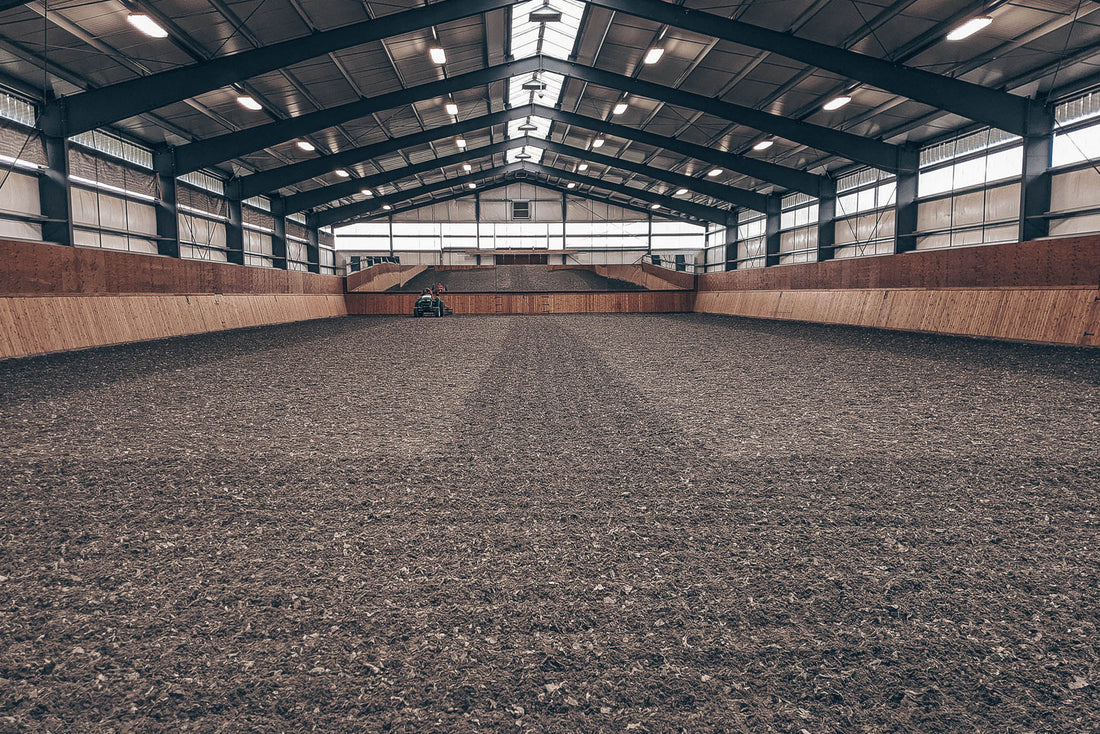How to Choose The Best Horse Arena Footing

Choosing your arena footing is one of the most critical aspects of building your arena. But what are the best options and how do you know what to choose?
Over the past few decades, new technologies appeared, and now there is real science in arena footing. A good arena surface has to provide your horse with the proper amount of support, or cushion, to prevent any damage or accidents. It should also offer the perfect balance between impact absorption and stability.
It’s also essential to choose an arena that doesn’t break down easily and is not dusty to make sure it doesn’t affect horses and riders’ lungs.
Read on to find out more about how to choose your arena footing, what your options are, and why it’s essential to choose wisely.
Ideal Arena Footing
The ideal footing formula depends on many aspects, such as the arena’s location and climate, so there’s no perfect recipe that will work for everyone. Also, the cost of the materials depends on local availability and transportation costs. But, as a general rule, here are the main aspects that an excellent footing has to offer:
- An even surface, free of holes and irregularities
- Shock absorbent, yet firm
- Non-slippery and with good traction
- Inexpensive and easy to maintain
What To Consider When Choosing The Arena Footing
There are many aspects you should be taking into consideration when choosing the best footing. As we mentioned above, there’s no perfect formula that could possibly cover everyone’s needs.
Here are a few questions that will guide you to choose the best footing for your arena:
- Is it an outdoor or indoor arena?
- What kind of maintenance does it require?
- What’s the climate in your area?
- What’s your riding discipline?
- How often will you use the arena?
- Will the footing interact well with the natural environment?
Understanding Footing Raw Materials
After you’ve answered the questions above, the next step is to understand the footing materials and how they work.
The arena footing is like a living organism. It will change over time, and as the old footing breaks down, you can top your arena with fresh material to renew its properties.
That’s why you might not get the right formula from the first try, and many great arena footings are a composite of two or more materials. The fundamental components of most footing are sand, silt, and clay. You can also add organic material or additives such as coatings, synthetic fibers, or rubber to enhance them.
You can use our WHOA Dust for most footing materials to ensure proper and even moisture retention, prevent dust from rising and reduce watering.
Next, let’s see how each of these materials combine and what are their characteristics, to help you choose the perfect footing for your arena.
What Are The Footing Options
Here are some of the most familiar footing materials you can mix and match to get your arena’s best surface. Before choosing anything, do your research: find out if the materials you need are available in your area and maybe visit other local arenas to see what kind of footing they use.
Sand
Sand is one of the most popular footing materials since it’s widely available and it’s not expensive. It can be used alone, but most of the time, it’s combined with other materials for best results.
Not any sand makes a good footing; make sure you choose cleaned and screened, medium, sharp sand since fine sand will break down faster. Sand drains well, but because of this, it must also be watered often to make sure it stays in shape.
Wood or rubber materials can be mixed with sand to provide better traction and stability. Wood retains water and improves traction, while rubber adds cushion and can prolong the footing’s lifespan.
We also recommend a biodegradable dust-control product such as WHOA Dust to ensure that your footing will require less watering and provide the best traction.

Wood
Wood products can be used as the main component of the footing or combined with other materials. Since it’s an organic material, it can degrade and break down relatively fast, so you have to add a new layer every couple of years.
Remember to check if the wood you want to use is suitable for horse arenas. For example, walnut or black cherry woods are toxic to horses, so make sure you stay away from them.
Also, wood footings may become slippery when they are overly wet; that’s why they might be more suitable for indoor arenas.
Rubber
Recycled rubber can be used with success as a horse arena footing. It’s usually used in sand mixtures to minimize compaction and add cushion to the footing. If used alone, it can be too bouncy, and the black color might catch too much heat if used in outdoor arenas.
Stone dust
Stone dust is a rather challenging material since it needs constant maintenance. It has excellent properties if it’s kept in proper conditions and you look after it often, but it can be devastating if it’s not maintained correctly.
It can provide good stability, and it drains well if it’s kept watered and harrowed. It’s a cheap material and widely available, but it can cost more in the long run due to frequent maintenance.


